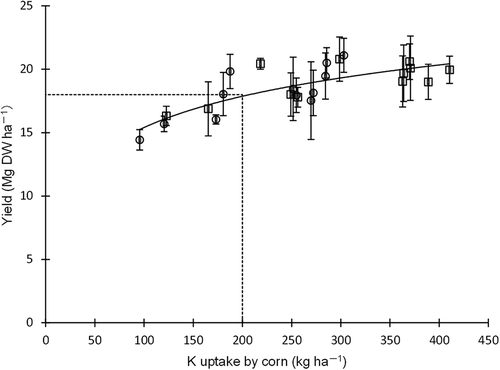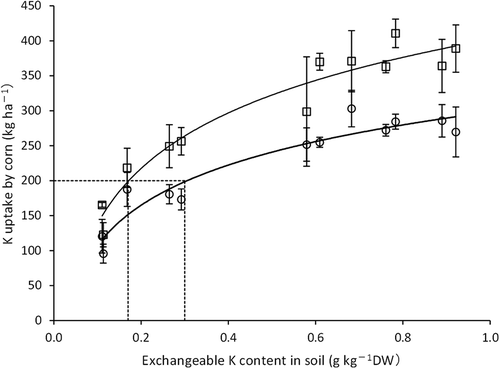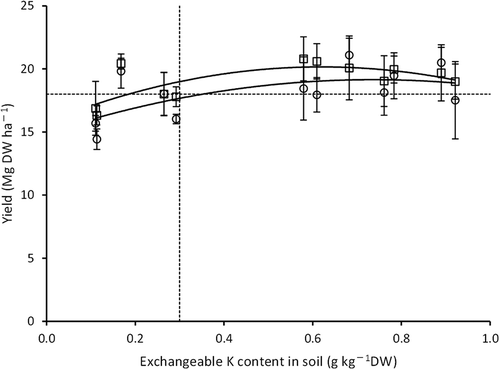Figures & data
Table 1 Varietal differences in yield, potassium (K) concentration and K uptake for forage corn (Zea mays L.) at the yellow-ripe stage (Experiment 1).
Table 2 Field management and soil chemical properties of five experimental fields in Experiment 2.
Figure 1 Relationship between the potassium (K) uptake by corn (Zea mays L.) and the corn yield in Experiment 2. Results consist of the data in 2005 (n = 4), 2006 (n = 4) and 2007 (n = 4), and are expressed as means ± standard deviation. The varieties ‘Cecilia’ and ‘Yumechikara’ are shown as circles (○) and squares (□), respectively. The solid lines are expressed as a regression curve in common with both varieties. The regression curve with the coefficient of determination (R2) using the yield as an outcome variable (y) and the K uptake by corn as a predictor variable (x) was y = 3.581 ln(x) – 1.11 with R2 = 0.623. The vertical and horizontal dashed lines indicate a K uptake of 200 kg ha−1 and a target yield of 18 Mg dry weight (DW) ha−1, respectively.

Figure 2 Relationship between the exchangeable potassium (K) content as an indicator for soil K fertility and the potassium uptake by corn (Zea mays L.) in Experiment 2. Results consist of the data in 2005 (n = 4), 2006 (n = 4) and 2007 (n = 4), and are expressed as means ± standard deviation. The varieties ‘Cecilia’ and ‘Yumechikara’ are shown as circles (○) with a lower solid line and squares (□) with an upper solid line, respectively. The regression curve with the coefficient of determination (R2) using the K uptake by corn as an outcome variable (y) and the exchangeable potassium (Ex-K) content in soil as a predictor variable (x) was y = 82.65 ln(x) + 298.4 with R2 = 0.923 for cv. Cecilia and y = 114.2 ln(x) + 402.1 with R2 = 0.941 for cv. Yumechikara. The vertical dashed lines indicate Ex-K contents of 0.17 and 0.30 g kg−1. The horizontal dashed line shows a K uptake of 200 kg ha−1. DW, dry weight.

Figure 3 Relationship between the exchangeable potassium (Ex-K) content in soil and the potassium (K) concentration in corn (Zea mays L.) in Experiment 2. Results consist of the data in 2005 (n = 4), 2006 (n = 4) and 2007 (n = 4), and are expressed as means ± standard deviation. The varieties ‘Cecilia’ and ‘Yumechikara’ are shown as circles (○) with a lower solid line and squares (□) with an upper solid line, respectively. The regression curve with the coefficient of determination (R2) using the K concentration in corn as an outcome variable (y) and the Ex-K content in soil as a predictor variable (x) was y = 3.804 ln(x) + 15.62 with R2 = 0.969 for cv. Cecilia and y = 5.221 ln(x) + 20.24 with R2 = 0.915 for cv. Yumechikara. The vertical dashed lines indicate Ex-K contents of 0.17 and 0.30 g kg−1. The horizontal dashed line shows a K concentration of 11 g kg−1 dry weight (DW).

Figure 4 Relationship between the exchangeable potassium (Ex-K) content in soil and the yield of corn (Zea mays L.) in Experiment 2. Results consist of the data in 2005 (n = 4), 2006 (n = 4) and 2007 (n = 4), and are expressed as means ± standard deviation. The varieties of ‘Cecilia’ and ‘Yumechikara’ are shown as circles (○) with a lower solid line and squares (□) with an upper solid line, respectively. The regression curve with the coefficient of determination (R2) using the yield as an outcome variable (y) and the Ex-K content in soil as a predictor variable (x) was y = − 7.843x2 + 11.52x + 14.91 with R2 = 0.389 for cv. Cecilia and y = − 11.64x2 + 14.37x + 15.75 with R2 = 0.561 for cv. Yumechikara. The vertical and horizontal dashed lines indicate an Ex-K content of 0.30 g kg−1 and a yield of 18 Mg dry weight (DW) ha−1, respectively. K, potassium.

Table 3 Soil chemical properties of fields A and F in Experiment 3.
Table 4 Response of corn (Zea mays L.) to potassium fertilizer application under low soil potassium fertility (Experiment 3).
Table 5 Response of corn (Zea mays L.) to potassium fertilizer application under high soil potassium fertility (Experiment 3).
Table 6 Newly suggested potassium fertilization based on soil diagnosis of exchangeable potassium for low potassium input production of forage corn (Zea mays L).
Table 7 Conventional soil diagnosis criteria of exchangeable potassium content and potassium fertilization for forage crops for Kanto and Tokai regions in Japan (NGRI Citation1988).
